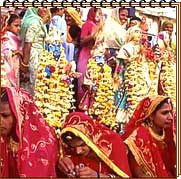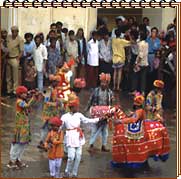|
 The Indian society is not a uniform one. This is a natural corollary to the fact that diversity is a part of Indian way of life. From region to region, diversity in the social structure is prominently seen. The north Indian social traditions and customs are markedly different and so those of the eastern India from those of other parts of the country. And here lies the tantalizing element of mystery associated with India. The Indian society is not a uniform one. This is a natural corollary to the fact that diversity is a part of Indian way of life. From region to region, diversity in the social structure is prominently seen. The north Indian social traditions and customs are markedly different and so those of the eastern India from those of other parts of the country. And here lies the tantalizing element of mystery associated with India.
The diversity factor notwithstanding, there is a common thread running through the Indians. Unity in diversity is best seen in India in a maze of seemingly disparate peoples. One social unifier is the Indian system of caste-ism adhered to by all racial groups belonging to the Hindu religion fold. Lambasted by many as a retrogressive social tradition, this system has also given the Indians a sense of belongingness to a shared way of life. Though caste rigidity was prevalent in the olden times, now it has become flexible to a large extent. It is not an uncommon to come across families of so called incompatible castes entering into matrimonial alliance.
The gender inequality is a phenomenon causing concern in the Indian society. The Indian society is highly prejudiced against the female gender. Basically a male dominated society, decision making at family and political level is almost single handedly handled by the men. Customs such as Dowry are worsening the process of subjugating women in the society. Of late, with social awareness about women's vital role in the development of a community or the country, there has been a change in the perception of gender equations in favor of women. Education of women, giving the women a greater say in decision making in the family and the governance are emphasized. With the liberalization of economy women are in top managerial position at par with the best men.
In spite of significant leaps made by India in the economic front, poverty is still a dominant social reality. A majority of the population of India lives in utter poverty without access to health care, housing, drinking water and education. Major policy change has to be enforced to better the lives of these millions souls if India is to become a truly desirable place to live in.
 Education is still a privilege in this country of over one billion people. Providing Primary education has been the motto of the government. So far the government has not live up to its promises with the results that there are more illiterate people than functionally literate people in India. Lack of education is the primary obstacle to the nation's development. India should educate the masses if its hope of becoming the global knowledge superpower is to become a reality.
Education is still a privilege in this country of over one billion people. Providing Primary education has been the motto of the government. So far the government has not live up to its promises with the results that there are more illiterate people than functionally literate people in India. Lack of education is the primary obstacle to the nation's development. India should educate the masses if its hope of becoming the global knowledge superpower is to become a reality.
India has a rich cultural and artistic heritage. The fact that India was invaded and ruled by various kings down the ages is already reflected by its impact on India culture. The Gupta dynasty, the Mughal dynasty and many other dynasties influenced and contributed to the Indian culture.
Music, inspired perhaps by the whistles of the wind or the splash of the waves, chirping of the birds or may be falling of the rain, exists on this land since the existence of humanity. They designed many musical instruments and innumerable ragas. Then developed different notes for different times, seasons and feelings. Different regions developed their own style of singing, not following the ragas but their own tunes and taking the lyrics in their own language and themes from their day-to-day life.
One of the powerful attractions in India is the colorful and diversified attire of its people. The silk saris, brightly mirrored cholis, colorful lehangas and the traditional salwar-kameez have fascinated many a traveler over the centuries.
For a single length of material, the sari must be the most versatile garment in existence. It is only one of the many traditional garments worn by women, yet it has somehow become the national dress of Indian women. A sari is a rectangular piece of cloth which is five to six yards in length. The style, color and texture of this cloth vary and it might be made from cotton, silk or one of the several man-made materials. The sari has an ageless charm since it is not cut or tailored for a particular size. This garment can fit any size and if worn properly can accentuate or conceal. This supremely graceful attire can also be worn in several ways and its manner of wearing as well as its color and texture are indicative of the status, age, occupation, region and religion of a woman.
Another popular attire of women in India is the salwar-kameez. This dress evolved as a comfortable and respectable garment for women in Kashmir and Punjab, but is now immensely popular in all regions of India. Salwars are pyjama-like trousers drawn tightly in at the waist and the ankles. Over the salwars, women wear a long and loose tunic known as a kameez. Though the majority of Indian women wear traditional costumes, the men in India can be found in more conventional western clothing. Men from all regions in India wear shirts and trousers. However, men in villages are still more comfortable in traditional attire like kurtas, lungis, dhotis and pyjamas.
The traditional lungi originated in the south and today men and women wear it alike. It is simply a short length of material worn around the thighs rather like a sarong. A dhoti is a longer lungi but with an additional length of material pulled up between the legs. Pyjama-like trousers worn by the villagers are known as the lenga.
Indian dressing styles are marked by many variations, both religious and regional and one is likely to witness a plethora of colors, textures and styles in garments worn by the Indians. Indian dance is a blend of nritta - the rhythmic elements, nritya - the combination of rhythm with expression and natya - the dramatic element. Most Indian dances take their themes from India's rich mythology and folk legends. Hindu gods and goddesses like Vishnu and Lakshmi, Rama and Sita, Krishna and Radha are all depicted in classical Indian dances. Each dance form also draws inspiration from stories depicting the life, ethics and beliefs of the Indian people.
 The genesis of the contemporary styles of classical dances can be traced to the period between 1300-1400 A.D. India offers a number of classical dance forms, each of which can be traced to different parts of the country. Each form represents the culture and ethos of a particular region or a group of people.
The genesis of the contemporary styles of classical dances can be traced to the period between 1300-1400 A.D. India offers a number of classical dance forms, each of which can be traced to different parts of the country. Each form represents the culture and ethos of a particular region or a group of people.
Bharatnatyam- Tamil Nadu; Kathak - Uttar Pradesh; Kathakali - Kerala; Kuchipudi- Andhra Pradesh; Manipuri - Manipur; Mohiniyattam - Kerala; Odissi - Orissa.
There is a multiplicity of festivals in India. Most of the festivals owe their origin to legends, gods and goddesses and mythology. As many communities there are, there are as many festivals unique to them. Color, gaiety, enthusiasm, feasts and a variety of prayers and rituals characterize festivals here. There are number festivals celebrated in India too numerous to count. Some important festivals are: Deepawali, Krishna Janmashtami, Onam, Dussehra, Pongal, Ramzan Id, Baisakhi Easter, Ganesha Chaturthi Holi, Raksha, Bandhan, Ram Navmi, Christmas, Good Friday, Makar Sankranti, Moharrum Shivratri, Durga Puja and many others.
Click on the following links to know more about INDIA.
India Facts and Figures |
History of India |
Geography of India |
Culture of India |
Economy and Infrastructure of India |
Future of India |
Map of India
| Recommended Tours |
Best of India Tour
Days : 08 Days / 07 Nights
Destinations : Delhi- Agra- Fatehpur Sikri- Jaipur- Udaipur
|
|
 |
|
|
 |
Splendid Rajasthan Tour
Days : 10 Days / 09 Nights
Destinations : Delhi-Udaipur-Narlai-Rohet-Jodhpur-Jaipur-Fatehpur Sikri-Agra
|
|
 |
Kerala Holidays Tour
Days : 13 Days / 12 Nights
Destinations : Cochin- Alleppey- Munnar- Periyar- Cardamom House- Madurai-Chennai
|
|
|
 |
|


